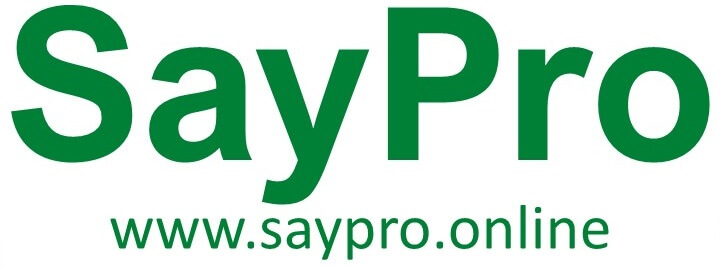Your basket is currently empty!

SayPro Marketing Daily Budget Preparation Training Course
R4 999,00
Description
1. Introduction to Budget Preparation
1.1 What is Budget Preparation?
Budget preparation is the process of planning and estimating the financial requirements needed for a project. A well-prepared budget ensures resources are allocated effectively and helps manage costs throughout the project. It acts as a financial roadmap for the project proposal or tender.
- Key Points to Understand:
- Purpose of Budget Preparation:To provide a financial framework for project execution.
- Financial Goals:Aligning financial estimates with the project’s objectives.
- Resource Allocation:Ensuring sufficient funding for resources, materials, labor, and unexpected contingencies.
1.2 Importance of Budgeting in Project Proposals & Tenders
Budgets play a crucial role in project proposals and tenders, as they:
- Help establish a realistic financial plan.
- Showcase the project’s feasibility.
- Demonstrate transparency to potential clients and stakeholders.
- Ensure that funds are available to execute the project successfully.
1.3 Key Concepts and Terminology in Budgeting
Understanding the terminology is key to effectively preparing budgets:
- Direct Costs:Expenses directly associated with the production of the project (e.g., labor, materials).
- Indirect Costs:Overhead costs not directly linked to the project but necessary for its execution (e.g., utilities, administrative costs).
- Contingency Fund:Money set aside for unexpected costs or changes in project scope.
- Profit Margin:The amount added to the cost to achieve profitability.
Tasks:
- Write a short description (200 words) of what budget preparation means in your own words.
- Identify and list at least five costs that could fall under direct and indirect costs in a typical marketing campaign.
- Share an example of how a contingency fund could be used in a real-world project.
Quiz:
- True or False:A budget only includes direct costs such as materials and labor.
- Multiple Choice:Which of the following is NOT a key concept in budgeting?
- A) Direct Costs
- B) Profit Margin
- C) Client Acquisition
- D) Contingency Fund
2. Understanding Project Budgets
2.1 Types of Project Budgets
There are various types of budgets depending on the nature of the project:
- Top-Down Budget:A budget decided by senior management and allocated to departments.
- Bottom-Up Budget:Created by individual project managers or teams, who estimate the costs and then submit them for approval.
- Zero-Based Budget:Every expense must be justified for each new period, with no assumptions made based on past budgets.
2.2 Components of a Budget
Typical components of a project budget include:
- Labor Costs:Salaries, wages, and benefits for project team members.
- Materials & Supplies:Raw materials, office supplies, software, and tools.
- Travel and Transportation:Expenses for travel, lodging, and transportation of team members if applicable.
- Miscellaneous Expenses:Any unclassified costs, such as client gifts, marketing collateral, or specialized services.
2.3 Cost Estimation Techniques
- Analogous Estimating:Using historical data from similar projects to estimate costs.
- Parametric Estimating:Using statistical data or algorithms to estimate costs based on certain parameters (e.g., cost per square foot).
- Bottom-Up Estimating:Estimating costs based on the specific details and tasks required for the project.
2.4 Fixed vs. Variable Costs
- Fixed Costs:Costs that do not change regardless of the level of work or output (e.g., rent, equipment).
- Variable Costs:Costs that change based on the level of project activity (e.g., raw materials, labor).
Tasks:
- Research and list three different types of project budgets used in your industry.
- Break down the costs in a typical project you are familiar with into fixed and variable costs.
- Choose a project you have worked on or would like to propose. Estimate costs using Analogous Estimating.
Quiz:
- Multiple Choice:Which of the following is an example of a fixed cost?
- A) Team travel expenses
- B) Software subscription
- C) Marketing collateral
- D) Raw materials for production
- Fill in the blank:____-Based Budgeting requires justifying every cost from scratch, without assuming anything from previous periods.
3. Steps to Prepare a Project Budget
3.1 Initial Research and Analysis
- Conducting market research to understand typical costs for similar projects.
- Analyzing historical data and understanding the external economic environment that may impact costs (e.g., inflation, market trends).
3.2 Defining Project Scope and Objectives
- Work with stakeholders to clearly define what the project will accomplish, and the boundaries of what will and will not be included.
- Establish key performance indicators (KPIs) to measure project success.
3.3 Identifying Key Budget Categories
- Labor
- Materials and supplies
- Equipment and tools
- Marketing and advertising
- Administrative costs
- Contingency funds
3.4 Creating a Cost Breakdown Structure
- Break the budget into smaller components, organizing costs by category or phase of the project.
- This makes it easier to track costs and ensure accuracy.
3.5 Estimating Resource and Operational Costs
- Estimate the costs of human resources, materials, equipment, etc.
- Identify any required resources and calculate costs using the techniques mentioned earlier.
3.6 Incorporating Contingency and Risk Factors
- Assess potential risks and uncertainties that could affect the project.
- Allocate a percentage of the budget (usually 5-10%) for contingency.
Tasks:
- Create a simple Cost Breakdown Structurefor a project you’re planning or familiar with. Include at least five categories of costs.
- Identify three risks that could affect the budget of a marketing campaign and propose possible contingencies for each.
- Using Bottom-Up Estimating, break down the project scope of a sample project and estimate resource costs.
Quiz:
- Multiple Choice:When defining the project scope, it’s essential to:
- A) Overestimate costs to avoid future problems
- B) Define the boundaries and objectives clearly
- C) Use the same scope from previous projects
- D) Neglect resource allocation in the beginning
- True or False:A contingency fund is only required if the project scope is vague or uncertain.
4. Tools and Techniques for Budget Preparation
4.1 Spreadsheet Tools (Excel, Google Sheets, etc.)
- Learn how to use basic functions like SUM, AVERAGE, and conditional formatting to track budget expenses.
- Use templates to set up cost tracking for each phase of the project.
4.2 Budgeting Software and Applications
- Popular tools like QuickBooks, Microsoft Project, and Trellocan assist in creating and managing budgets efficiently.
- These tools help manage resources, track costs, and generate real-time financial reports.
4.3 Time Tracking and Cost Monitoring Tools
- Tools like Harvest, Toggl, and Clockifyhelp track time spent on tasks, which can help in estimating labor costs.
- Cost monitoring tools provide up-to-date financials throughout the project.
4.4 Templates for Proposals and Tenders
- Using predefined templates for proposal budgets can save time and ensure consistency.
- Templates can be customized for specific project types and client requirements.
Tasks:
- Find and download a free budget template online. Customize it for a marketing project proposal.
- Use a Time Tracking Toollike Harvest to estimate the cost of labor for a project you are familiar with.
- Create a project budget using Excel or Google Sheets, including labor, materials, and miscellaneous expenses.
Quiz:
- Multiple Choice:Which of the following tools is NOT primarily used for budget preparation?
- A) Excel
- B) QuickBooks
- C) Trello
- D) Adobe Photoshop
- True or False:Time-tracking tools only track employee hours, not financial costs.
5. Budgeting for Different Types of Projects
5.1 Marketing Campaign Budgets
Marketing campaigns often have specific budget categories, such as:
- Advertising Costs:TV, radio, print, digital ads, etc.
- Creative Development:Design, copywriting, content creation.
- Media Buying and Placement:Purchasing ad space or time.
- Influencer Partnerships:Fees for working with influencers or brand ambassadors.
5.2 Event Management Budgets
Event planning requires careful allocation for:
- Venue Costs:Rental fees, security, catering, AV equipment.
- Promotional Materials:Banners, flyers, giveaways.
- Speakers and Performers:Fees and travel expenses.
- Logistics and Staffing:Transport, accommodations, and personnel.
5.3 IT and Software Development Project Budgets
IT and software projects tend to focus on:
- Development Tools and Software Licenses:Costs for development environments, tools, and software platforms.
- Salaries:Programmers, system architects, UI/UX designers.
- Testing and QA:Ensuring the software meets requirements through rigorous testing.
- Hosting and Infrastructure:Cloud services, servers, and databases.
5.4 Construction Project Budgets
Construction projects have very specific budgeting needs:
- Materials:Concrete, steel, and other raw materials.
- Labor:Builders, electricians, plumbers, etc.
- Equipment Rentals:Cranes, bulldozers, and scaffolding.
- Regulatory Fees:Permits, inspections, and safety compliance costs.
5.5 Research and Development Budgets
In R&D, budgeting revolves around:
- Labor and Expertise:R&D staff salaries, consultants, and specialists.
- Materials and Prototyping:Raw materials and prototypes for testing.
- Testing and Analysis:Equipment and facilities to test hypotheses or products.
- Intellectual Property Protection:Patents, trademarks, and legal fees.
Tasks:
- Create a Sample Budget for a Marketing Campaign: Break down the typical costs involved in a digital marketing campaign (advertising, design, content creation, etc.).
- Research a Construction Project Budget: Identify the primary cost categories and estimate how they might vary between residential and commercial projects.
- Budgeting for Software Development: Estimate the costs for a small app development project, covering labor, tools, and infrastructure.
Quiz:
- Multiple Choice:Which of the following is typically a cost in an IT project budget?
- A) Development Tools and Software Licenses
- B) Media Buying and Placement
- C) Venue Rental
- D) Catering
- True or False:Construction projects usually do not require an IT-related budget item.
6. Review and Refinement of Budget Proposals
6.1 Reviewing Cost Estimates for Accuracy
It’s important to regularly revisit and review the budget to ensure the estimates are realistic and up-to-date. Steps include:
- Double-checking Estimates:Compare with similar past projects.
- Adjusting for Changes:If new costs have emerged, they should be added to the budget.
- Consulting with Experts:Involve project leads, department heads, or external consultants to ensure accuracy.
6.2 Adjusting Budget to Meet Client or Internal Requirements
Budgets should be flexible enough to meet the expectations of the stakeholders:
- Client Adjustments:Clients may request changes that affect the budget, requiring revisions.
- Internal Adjustments:Internal constraints, such as limited resources or time, might require cutting certain costs.
- Negotiation:Be prepared to negotiate between quality, scope, and costs.
6.3 Identifying and Addressing Potential Budget Issues
Common budget issues include:
- Overestimating/Underestimating Costs:Ensuring costs are realistic.
- Resource Constraints:Lack of funds or resources to complete certain phases of the project.
- Inflation or Price Changes:Adjusting for unexpected changes in costs.
6.4 Finalizing the Budget for Proposal Submission
Once all adjustments are made, it’s time to finalize the budget:
- Organizing the Budget: Ensure clarity and transparency in the final document.
- Final Review:A thorough review should be done to make sure it aligns with project goals and meets all stakeholder expectations.
- Approval Process:Ensure the final budget is approved by project managers, clients, and financial officers.
Tasks:
- Conduct a Budget Review: Review your marketing campaign budget and suggest three areas where costs could be adjusted or reduced.
- Adjust a Sample Budget: Suppose a client has asked for a 10% reduction in costs. Go through the budget and make the necessary adjustments without sacrificing key deliverables.
- Address Potential Issues: List three potential issues that could arise in the construction budget you previously created and how you would address them.
Quiz:
- Multiple Choice:Which of the following is the first step in refining a project budget?
- A) Finalizing the budget
- B) Reviewing cost estimates for accuracy
- C) Cutting costs across the board
- D) Asking clients to approve the changes
- True or False:A well-prepared budget can never be adjusted after initial submission.
7. Budget Presentation for Proposals and Tenders
7.1 Creating a Professional and Clear Budget Presentation
Once the budget is complete, it needs to be presented clearly:
- Organizing Information: Break down the budget into digestible sections (e.g., labor, materials, overheads).
- Visualization Tools: Use graphs, charts, and tables to help illustrate costs.
- Executive Summary: Include a high-level summary for stakeholders who might not need the details.
7.2 Communicating Budget Assumptions and Rationale
Explain how you arrived at your cost estimates:
- Assumptions:Clearly state any assumptions made (e.g., labor costs will increase by 3% due to inflation).
- Justifications:Provide explanations for why certain costs are included or why adjustments were made.
7.3 Aligning Budget with Client Expectations and Goals
Ensure the budget supports the goals of the client or the project:
- Project Scope Alignment:Show how costs are directly tied to delivering project outcomes.
- Cost-Efficiency:If needed, adjust the budget to reflect more cost-effective strategies without compromising quality.
7.4 Common Pitfalls to Avoid
- Over-complicating the Budget: Keep the presentation simple and to the point.
- Being Vague with Justifications: Avoid presenting estimates without clear explanations for stakeholders.
- Ignoring Client Feedback: Always incorporate client feedback and revisions into the final proposal.
Tasks:
- Create a Budget Presentation: Prepare a professional budget presentation for a marketing project. Include sections for labor, materials, and overheads.
- Explain Budget Assumptions: Write a short rationale explaining the assumptions made in your budget, such as anticipated labor rates or material costs.
- Align Budget to Client Needs: Create a one-page document where you demonstrate how your budget meets the specific goals and expectations of a client.
Quiz:
- Multiple Choice:Which of the following is a critical part of presenting a project budget?
- A) Avoid including charts and graphs
- B) Explain the assumptions behind cost estimates
- C) Leave out the budget’s rationale to save space
- D) Overestimate costs to appear more transparent
- True or False:A budget presentation should be complex and filled with every detail from the budget sheet.
8. Managing and Monitoring Project Budgets
8.1 Tracking Actual Expenses vs. Estimated Budget
Once the project starts, monitor spending closely:
- Tracking Tools:Use spreadsheets or budget management software to track actual expenses against estimated costs.
- Variance Reports:Identify if there are any discrepancies between the estimated and actual costs.
8.2 Adjusting Budgets During Project Execution
In the course of a project, adjustments may be necessary:
- Scope Changes:If the scope changes, the budget may need to be adjusted accordingly.
- Unexpected Costs:New costs might emerge, requiring funds to be reallocated.
8.3 Reporting and Documenting Financial Progress
Regular reporting is necessary:
- Internal Reports:Keep stakeholders updated on financial progress and any potential risks.
- Client Reports:Present clear, concise reports to clients to keep them informed.
8.4 Lessons Learned for Future Budgeting
Post-project reviews provide valuable insights:
- Budget Accuracy:Compare initial budget estimates with final costs.
- Improvement Areas:Identify any areas for improvement in future budget preparation.
Tasks:
- Track Actual vs. Estimated Costs: Use a sample project budget (you’ve created or found) and track actual costs against the estimates.
- Adjust a Project Budget During Execution: Imagine a scenario where a new unexpected cost arises (e.g., materials cost increases). Reallocate your funds to cover the new cost without exceeding the total budget.
- Post-Project Review: After completing a mock project, review the budget and highlight what went well and where improvements can be made.
Quiz:
- Multiple Choice:When should you adjust a project budget?
- A) Only after project completion
- B) Immediately after starting the project
- C) If there are scope changes or unexpected costs
- D) Never, the budget should stay fixed
- True or False:Project budgets should only be reviewed at the end of the project.
9. Practical Exercises and Case Studies
9.1 Case Study: Marketing Campaign Budget Preparation
- Students will review a case study of a marketing campaign and develop a budget from scratch. They’ll estimate costs for media buying, content creation, staffing, and tools.
9.2 Case Study: Tender Budgeting for Construction Projects
- A construction company is preparing a tender for a new project. Students will assess the budget based on given parameters like labor, equipment, and materials.
9.3 Practical Exercise: Budgeting for a Real-World Project
- Using a real-world project (either based on past experience or a hypothetical scenario), students will prepare a complete project budget, following all the steps covered in previous sections.
9.4 Group Discussion: Common Budgeting Challenges
- Students will participate in a group discussion to share budgeting challenges they’ve faced and how they overcame them.
10. Course Summary and Key Takeaways
10.1 Recap of Budget Preparation Process
A review of the budgeting process covered throughout the course.
10.2 Final Tips and Best Practices
Key tips for creating and managing effective budgets:
- Stay organized and track expenses regularly.
- Be transparent about assumptions and changes.
- Always review your budget before submission.
10.3 Q&A Session
Open session for students to ask any remaining questions about project budgeting.
11. Additional Resources and Tools
- Recommended Reading: Books and articles on budgeting best practices.
- Budgeting Software Recommendations: List of tools to help students create and manage budgets.
- Links to Online Courses and Certifications: Additional courses for further learning.
12. Course Evaluation and Feedback
12.1 Course Feedback Form
Students are asked to fill out a feedback form to evaluate the course content and delivery.
12.2 Suggestions for Future Training Sessions
Students provide suggestions for additional topics or improvements to future sessions.
You must be logged in to post a review.
Vendor Information
- No ratings found yet!









Reviews
There are no reviews yet.